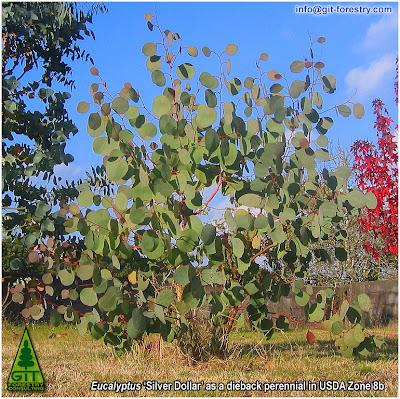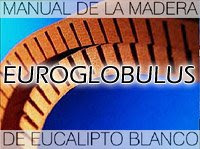Snow Gums: cold hardy Eucalyptus from Alpine Australia
Notes on taxonomy and cultivation in cold temperate climates
Gustavo Iglesias Trabado
GIT Forestry Consulting - Consultoría y Servicios de Ingeniería Agroforestal - www.git-forestry.com - EUCALYPTOLOGICS
 Fig 1: Adult leaves and blooms of a Snow Gum (E. pauciflora ssp. pauciflora) flowering in the Tablelands of Galicia (NW Spain)
Fig 1: Adult leaves and blooms of a Snow Gum (E. pauciflora ssp. pauciflora) flowering in the Tablelands of Galicia (NW Spain)
Notes on taxonomy and cultivation in cold temperate climates
Gustavo Iglesias Trabado

GIT Forestry Consulting - Consultoría y Servicios de Ingeniería Agroforestal - www.git-forestry.com - EUCALYPTOLOGICS
 Fig 1: Adult leaves and blooms of a Snow Gum (E. pauciflora ssp. pauciflora) flowering in the Tablelands of Galicia (NW Spain)
Fig 1: Adult leaves and blooms of a Snow Gum (E. pauciflora ssp. pauciflora) flowering in the Tablelands of Galicia (NW Spain)Pauci = few + flora = flowers. I would not discard the botanist assigning such a scientific name to this Snow Gum (Cabbage Gum) being a bit of ironic! Individual flower size in Eucalyptus pauciflora is relatively small, but about a dozen of them grow in each inflorescence, giving the blooms the outlook of a bigger flower, more or less the size of a golf ball.
A very cold hardy eucalypt species (reports of good survival with little damage as low as -18ºC), correct seed sourcing from the right subspecies and provenances (see below) is important to obtain cold hardy plants in the long term. Warning: it can become a huge tree ... with some exceptions!
 Fig. 4: Eucalyptus pauciflora ssp. debeuzevillei blooming at Ray Mattei's Tropic to Tropic garden in South Delta (British Columbia, Canada)
Fig. 4: Eucalyptus pauciflora ssp. debeuzevillei blooming at Ray Mattei's Tropic to Tropic garden in South Delta (British Columbia, Canada)
 Fig. 5: Eucalyptus pauciflora ssp. debeuzevillei growing at Jost Wallis' Magnolia Garden in Tecklenburg (Nordrhein-Westfalen, Germany)
Fig. 5: Eucalyptus pauciflora ssp. debeuzevillei growing at Jost Wallis' Magnolia Garden in Tecklenburg (Nordrhein-Westfalen, Germany)
Pauciflora Complex : Eucalyptus pauciflora related taxa
 Fig. 6: Eucalyptus gregsoniana (ex E. pauciflora var. nana) blooming at Dr. John G. Purse eucalypt collection (Primabio, Kent, United Kingdom)
Fig. 6: Eucalyptus gregsoniana (ex E. pauciflora var. nana) blooming at Dr. John G. Purse eucalypt collection (Primabio, Kent, United Kingdom)
 Fig. 7: Eucalyptus lacrimans in the high tablelands of New South Wales. Photo courtesy of Phil in Sydney (Eucalypts in Habitat).
Fig. 7: Eucalyptus lacrimans in the high tablelands of New South Wales. Photo courtesy of Phil in Sydney (Eucalypts in Habitat).
So as we see, most of the Eucalyptus pauciflora subspecies can be grown with safety in areas with harsh winters corresponding to USDA Hardiness Zone 7. We include them in category ATL2 (absolute minima from -10 to -15ºC) for long term cultivation. Suitable seed provenances and origins of the most cold tolerant subspecies (mainly spp. debeuzevillei and ssp. niphophila) could be tried with much caution in protected microclimates of the mildest part of USDA Zone 6 (average yearly absolute minima below -17 to -23ºC), expecting frost damage and risk for long term survival except as a perennial behaved shrub (dieback and resprout from coppice).
© 2008 Gustavo Iglesias Trabado. Please contact us if you want to use all or part of this text and photography elsewhere. We like to share, but we do not like rudeness.
A very cold hardy eucalypt species (reports of good survival with little damage as low as -18ºC), correct seed sourcing from the right subspecies and provenances (see below) is important to obtain cold hardy plants in the long term. Warning: it can become a huge tree ... with some exceptions!
Pauciflora Complex : Eucalyptus pauciflora subspecies
- E. pauciflora ssp. pauciflora - Whatever is not one of the following...
- E. pauciflora ssp. debeuzevillei - The Snow Gum of Wilfred de Beuzeville, an Australian forester with family roots in Normandy (France). Very cold hardy, the Jounama Snow Gum can resist -15ºC easily, and -20ºC exceptionally, so we can consider it a species suitable for cultivation in harsh climates of Atl2 zone. There are mentions of resistance to short spells of -23ºC, which would be one the extreme cold tolerance records for Eucalyptus.
- E. pauciflora ssp. niphophila - Its botanical name meaning "snow lover", it can resist as the previous type -15ºC easily and -20ºC exceptionally. A high elevation (+1000 m) snow gum that in restrictive conditions becomes a multistemmed mallee of small size. Also suitable for cultivation in harsh climates of Atl2 zone.
- E. pauciflora ssp. acerina - Its botanical name could mean either "ressembling a maple" or "non waxy", which we cannot comment on given the rarity of this new subspecies (named by Kevin Rule in 1994) in cultivation. It is also known as Baw Baw Sallee, and it is another high altitude (+1200 m) endemism. At lower elevations it intergrades with E. pauciflora ssp. pauciflora. Very possibly also suitable for cultivation in the Atl2 zone.
- E. pauciflora ssp. hedraia - Its botanical name meaning "sessile", the Bogong Sallee is also uncommon in cultivation. In its restricted native habitat the Falls Creek Snow Gum can reach variable heights, from 5 to 20 m, and is normally multistemmed. Possibly suitable for cultivation in Atl2 zone.
- E. pauciflora ssp. parvifructa - Its botanical name meaning "small fruited", the Grampians Sallee. Some authors consider Mt. William Snow Gum just a high altitude (+900 m) minor form of E. pauciflora ssp. pauciflora of small size and mallee habit. Dean Nicolle's trials show it has better tolerance to drought than other subspecies. Again, an Atl2 zone tree.
 Fig. 4: Eucalyptus pauciflora ssp. debeuzevillei blooming at Ray Mattei's Tropic to Tropic garden in South Delta (British Columbia, Canada)
Fig. 4: Eucalyptus pauciflora ssp. debeuzevillei blooming at Ray Mattei's Tropic to Tropic garden in South Delta (British Columbia, Canada) Fig. 5: Eucalyptus pauciflora ssp. debeuzevillei growing at Jost Wallis' Magnolia Garden in Tecklenburg (Nordrhein-Westfalen, Germany)
Fig. 5: Eucalyptus pauciflora ssp. debeuzevillei growing at Jost Wallis' Magnolia Garden in Tecklenburg (Nordrhein-Westfalen, Germany)Pauciflora Complex : Eucalyptus pauciflora related taxa
 Fig. 6: Eucalyptus gregsoniana (ex E. pauciflora var. nana) blooming at Dr. John G. Purse eucalypt collection (Primabio, Kent, United Kingdom)
Fig. 6: Eucalyptus gregsoniana (ex E. pauciflora var. nana) blooming at Dr. John G. Purse eucalypt collection (Primabio, Kent, United Kingdom)- E. pauciflora var. nana - An invalid botanical name meaning "small sized" and corresponding to E. gregsoniana or the Wolgan Snow Gum, which indeed is a small sized when adult and slow growing tree, but not as cold hardy as some of the other already mentioned, with cases of not resisting much below -10ºC to coping well with short spells down to -15ºC. Suitable for cultivation in mild microclimates of Atl2 zone.
- E. pauciflora var. alpina - Another invalid botanical name, it can be translated as E. pauciflora ssp. niphophila.
- E. pauciflora var. lacrimans - Another invalid botanical name meaning "weeping" and corresponding to E. lacrimans, which is medium sized when adult and also a slow growing Snow Gum able to resist -15ºC and possibly lower temperatures. Suitable for cultivation in mild microclimates of Atl2 zone.
 Fig. 7: Eucalyptus lacrimans in the high tablelands of New South Wales. Photo courtesy of Phil in Sydney (Eucalypts in Habitat).
Fig. 7: Eucalyptus lacrimans in the high tablelands of New South Wales. Photo courtesy of Phil in Sydney (Eucalypts in Habitat).So as we see, most of the Eucalyptus pauciflora subspecies can be grown with safety in areas with harsh winters corresponding to USDA Hardiness Zone 7. We include them in category ATL2 (absolute minima from -10 to -15ºC) for long term cultivation. Suitable seed provenances and origins of the most cold tolerant subspecies (mainly spp. debeuzevillei and ssp. niphophila) could be tried with much caution in protected microclimates of the mildest part of USDA Zone 6 (average yearly absolute minima below -17 to -23ºC), expecting frost damage and risk for long term survival except as a perennial behaved shrub (dieback and resprout from coppice).
Interesting links
 Scandinavia & Eucalyptus: flowering at 61ºN : Read about some of the Northernmost Snow Gum Eucalyptus in the world growing around Nautesund Plantesalg in the fjords of Norway!
Scandinavia & Eucalyptus: flowering at 61ºN : Read about some of the Northernmost Snow Gum Eucalyptus in the world growing around Nautesund Plantesalg in the fjords of Norway!
 Eucalyptus and Snow: Watch some winter views of cold hardy Eucalyptus timber crops under the snow in Galicia (Northwestern Spain) taken by GIT Forestry Consulting
Eucalyptus and Snow: Watch some winter views of cold hardy Eucalyptus timber crops under the snow in Galicia (Northwestern Spain) taken by GIT Forestry Consulting
 Eucalyptus as Dieback Perennials: Learn how to take advantage of Eucalyptus resurrection after frost damage to ornamental plantings done with borderline species for your winters
Eucalyptus as Dieback Perennials: Learn how to take advantage of Eucalyptus resurrection after frost damage to ornamental plantings done with borderline species for your winters
 Scandinavia & Eucalyptus: flowering at 61ºN : Read about some of the Northernmost Snow Gum Eucalyptus in the world growing around Nautesund Plantesalg in the fjords of Norway!
Scandinavia & Eucalyptus: flowering at 61ºN : Read about some of the Northernmost Snow Gum Eucalyptus in the world growing around Nautesund Plantesalg in the fjords of Norway! Eucalyptus and Snow: Watch some winter views of cold hardy Eucalyptus timber crops under the snow in Galicia (Northwestern Spain) taken by GIT Forestry Consulting
Eucalyptus and Snow: Watch some winter views of cold hardy Eucalyptus timber crops under the snow in Galicia (Northwestern Spain) taken by GIT Forestry Consulting Eucalyptus as Dieback Perennials: Learn how to take advantage of Eucalyptus resurrection after frost damage to ornamental plantings done with borderline species for your winters
Eucalyptus as Dieback Perennials: Learn how to take advantage of Eucalyptus resurrection after frost damage to ornamental plantings done with borderline species for your wintersEucalyptus: Cold Hardy Species Guide to Cultivation in Europe: Read a bit about GIT Forestry Consulting's suggestions of suitable areas and general indications on absolute minimum temperatures that allow cultivation of cold hardy provenances of frost tolerant Eucalyptus species in the Atlantic and Mediterranean climates of Europe.
Winter View of Snow Gums in habitat at Bogong Ridge (NSW, Australia): Or how you are wished a Happy Eucalyptus Growing during 2008 by GIT Forestry Consulting & EUCALYPTOLOGICS' staff.
![]() Subscribe to receive EUCALYPTOLOGICS via RSS
Subscribe to receive EUCALYPTOLOGICS via RSS
© 2008 Gustavo Iglesias Trabado. Please contact us if you want to use all or part of this text and photography elsewhere. We like to share, but we do not like rudeness.



































![Validate my Atom 1.0 feed [Valid Atom 1.0]](http://gus.iglesias.googlepages.com/valid-atom.png)






















0 Comments by our readers :::
Send a comment to EUCALYPTOLOGICS